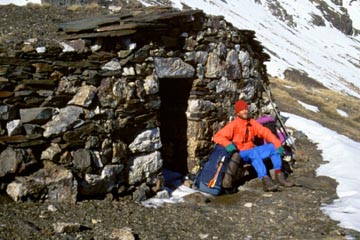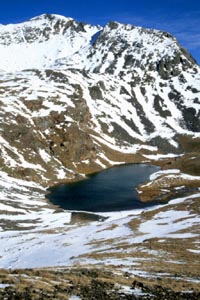In detail ...
Before sunrise we awoke in the gloom of our secure but cold shelter to noise; the talk of approaching herdsmen, or was it a bark from their dogs?
In exiting to find out, we inattentively un-latched the refuge door, and immediately regretted allowing the dogs in, for they pissed greetings to each other on the supporting pillars. Only household pets need toilet training;
these working animals confronted taboo infrequently, and certainly didn't recognise it in the austere concrete decor of the refuge. I had found little comfort in the unyielding refuge beds; perhaps that accounted for some lower back ache, or was it cold in the kidneys? I packed stiffly, using up some torch power to aid packing, drank some hot water and ate a half apple ration. Karen was still busy after I completed this, so I bundled all the left rubbish possible and took it to the bins; ice flows on the path spelled a warning.
Karen_comments
By 8:30am we were out, eager to gain our first col which held a breakfast promise; perhaps it would also bring us some sun? Red and yellow
balisage led us on, and in fact right through Andorra. We wandered among the scattered pines in the main valley, the path dirty with the passage of bovine herds. Then a steepening led us out via a
collet where we broke free of the trees. The pass moved us into a cleaner grassy valley where the route was well defined, even into the snowfields at about 2500m. That was fortunate, as the natural col at 2673m lured us to the south, while the worn passage of access rose 40m higher, to 2713m.
The west facing slopes we travelled were shaded from the early sun, leaving the snow icy. The hard packed
névé was initially avoidable, lying in long fingers which clawed at our security, but as we approached the pass on ever steeper terrain, we were forced to stamp hard to gain purchase. Our efforts were aided considerably by a set of footprints, a lone traveller had crossed the pass since the snow fell. But for this, we would have been forced to cut steps tediously with ice axes, and progress would have reduced to a crawl. Some alarming slips added to the interest, though there was no risk of any serious slide developing.
During the final few metres to gain Collada dels Meners (2713m), we were further assisted by the wind at our backs, but this strengthening icy blast then threatened to blow us right through the rocky notch. We were forced to cling to the rocks by any means available.
Karen_comments
What a joy to meet the sun though, still in its early golden hue. The shaley black screes on the east side were bare of snow, aiding rapid descent to a small cave-like
cabane built into the hillside where we sat on the rocks to eat a welcome breakfast; dry biscuits complemented the soaked figs perfectly.
As it was buried in the rucsac, my camera had not recovered from the morning's chill, and this occasioned some curses; the shutter release of my now ancient Pentax MX is not battery dependent, but correct exposure depends on electronics. Possible options: wrestle to clean the contacts, warm the battery, or just guess the light. I warmed the battery but only at the expense of chilled fingers. Our route ahead lay as a great traverse around the head of Vall de Ransol, but much of it was blocked from view by a small hillock in front. We turned away from the
lacquet Estany del Meners and descended steeply around the hillock, to set eyes on another guiding
lacquet at 2440m and review the unfolding route beyond.
After skirting the lake and a smaller sibling, we gained a narrow balcony path, exposed but secure which led us with slight ascent into a small
cirque. An easy scramble across slabby rocks brought us to the Coms de Jan refuge, which was furnished in a similar practical fashion to Sorteny; outside at the front, we noted 2 x 1m
3 litter bin 'cages'. Our inspection was barely complete when we heard a helicopter which, it transpired, was heading straight for us. Its direct approach brought it to a hover 30m overhead, so we took shelter from the downblast, wondering what its business might be. A cable and maillon was lowered, and within a few minutes, the whole noisy contraption had landed about as close to the refuge as its whirling rotor blades allowed; fascination swelled. A door opened and out leapt a casually dressed young woman; no helmet or other safety equipment. She scurried beneath the scything blades, grabbed the cable, hurried to one of the litter bins, and attached it. The former events were reversed speedily, and soon the chopper lifted off with its precious cargo and dissappeared.
We emerged from respective hiding places to chorus simultaneously 'Isn't that ridiculous!' The cage barely held two carrier bags worth of refuse. Obeying instructions (and common sense!) we had packed our rubbish away from every refuge in France and Spain, but here in Andorra, we could leave it to an extravagent state sponsored airlift. Of course, this facility would encourage people to come into the mountains, and leave their litter in the right place; using a chopper would avoid erosion, but at what price the energy?
Peace returned as we headed off, following the GRP1 markers into a gully and along the stream. From there however, we struck out across less travelled ground, scrambling through craggy ribs which occasioned a yelp from Karen; a large rock she had pulled upon had shifted disconcertingly. Then we gained steep screes with little trace of passage beneath a cliff. Ascending past the screes, we once more entered the snow; happily, quite soft and often avoidable. Karen continued to make good use of the trusty
baton which I had fashioned for the river crossings. This was a stout piece of fresh hazel, which added siginificantly to her load, but it helped on steeper ground. The stick might yet come in useful for another river crossing.
The Cricket
French; 'Criquet'. Certain species show adaptation to the extremes of the alpine stage by way of
melanisme , development of pigments which protect them from intense UV light. Standard green varies through yellow, red, purple, or even variegated colours in body and thigh. True grasshoppers (with which crickets are often confused) and many crickets fly ably, but the vestigial wings of these mountain dwellers reduce them to hopping and walking. Size is 2cm to 3cm, though the female is substantially the larger. Don't worry if you step on a few, more will die when the next flock of choughs swoop down!
Collada del Clot Sord (2450m) was a vantage point with views all round, being elevated upon the 'snout' of a high ridge. Our first col was visible to the west
Voici!
while ahead, we looked down into the Vall d'Inclès. There we paused in the sun, content that all the hard ascent was complete. The crickets invited contemplation, they were lively and prolific here. We had first observed them while mounting the first pass where the frosty shade induced torpor, their inaction seeming to invite death from a careless footstep. On the sunny side of the first pass they could actually manage a hop, while here they sprang up
au hasard at every footstep like hot popcorn. We were especially amused by the mating couples travelling as a unit; the smaller male would ride the female 'jockey', sometimes with long hopping legs sticking up clear, like a race-winner in victory salute. The gesture was a mere practicality to facilitate locomotion.
At the col, we were well above the tree-line, but the lower, steeper slopes were tree-covered. The guide did not suggest a specific route to the valley bottom, and Véron's description of doing a 'schuss' through the trees did not appeal. We were therefore easily persuaded by an ancient red
balisage which contoured and fell by turns to the northeast; it took us past a collection of sombre
lacquets but we saw no creatures in these Basses des Salamanders. Then we lost all trace, but continuing east, found an excellent path with yellow
balisage which led us right down to the valley road; the small penalty of 'zagging' back down the valley was thus amply re-paid.
This Andorran valley with its hamlets and church was reminiscent of Switzerland; large chalet-style homesteads with dark stained wood-panelling and stone flag roofs, set in green pastures stippled with the purple flecks of the
colchique. It was all a bit smarter, cleaner and wealthier than what we were used too. That did not bode well for our destination, Camping d'Inclès; it would likely be too commercial and expensive to pull us in, but perhaps it might just offer a tasty supplement towards supper? We travelled the tarmac hopefully, but over a span of 2km nowhwere found any sign of
hebergement or snacks; perhaps it was the ochre-wash rendered bar-restaurant, which stood out from the others with their white walls. No doubt we were out of season once more.
That left us with the expected alternative of seeking Ref Siscaro, a 250m climb out of the valley. We took the
lacets which criss-crossed the cascading stream, rising through the woods. I arrived at the marshy flats ahead of Karen to gain the sunlight, but not for long; it had departed the refuge and was creeping up the boulder screes, forcing me to relocate a couple of times. The refuge was very much like the others already encountered; secure, basic, tidy, and complete with rubbish crate for aerial collection. It was already appropriated by a lone Frenchman, whose presence tipped the dilemma between lumpy but soft grass versus cold flat steel. We could still be sociable in using the refuge to shelter while cooking and eating.
Our companion was out for a tour of several days, travelling part of the HRP in contra-sense to us. He helped us with some of the guidebook vocabulary and chatted about the weather, the refuges and
bears. Had he seen one? No, but he had seen
a footprint in the snow once! That was more than we had seen. Lifting a dinky
portable from his jacket, he excused himself to make a call; it didn't take him long to establish there was no signal. He continued to entertain us with warnings of impending snow-fall; there was that occasion when he could barely open the refuge door after a heavy overnight deposit. This threat of snow still hung over us, but the Great Triad and even the last 3000m peak were well behind now. Just one more easy stage would see us enter the Pyrénées Orientale; couldn't we expect the promised 'Mediterranean influence' to clear our passage ahead? We bade our friend goodnight and retired to try out the springy turf that we hoped would afford us a good night's sleep.


